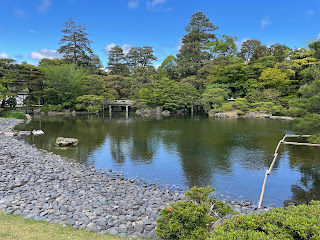For our final full day in Japan, we traveled by subway and local train to visit the Fushimi Inari Shrine at the base of Mount Inari. Dating from the 10th century C.E., this shrine is most noted for more than 10,000 torii, or ceremonial gates, all painted orange (or "vermillion" as the promotions all say).
As one climbs higher up the mountain, the gates take on different sizes. It's pretty interesting for the first 1,000 or so, then it gets a bit repetitive.
People come to this Shinto shrine to pray for whatever it is they are wishing for. If the wish is granted, one purchases a torii that is inscribed with a name and dedication. That gate stands until it rots or until the donor is no longer supporting it, then it is removed and replaced by one donated by someone else.
Perhaps more interesting (at least for one member of our family) is that the "messenger animal" for the god of this shrine is the fox. There were statues of foxes everywhere, as guardians of the shrine. The Shinto priests were even selling wooden fox faces that you could write your prayers on, then leave at the shrine for the gods to read and perhaps answer.
As one climbs higher, there are stone altars adorned with miniature symbolic torii and sometimes with candles or incense burners. Many of the altars also had carvings or statues of foxes. But most are not cute, cuddly foxes. As guardians of the shrine, they all look pretty fierce.
After spending a bit too much time at Fushimi Inari, we got back on the local train and returned to Kyoto Station. Across the street from the station is a commercial building where we found a small sushi school on the second floor.
The sushi chef had prepared rice, fish, and other ingredients for us. After telling us something about his life and work, he began giving us a lesson in sushi preparation.
Of course, the difficult parts had already been done for us: Selecting and slicing the fresh seafood, preparing the rice, etc. But he led us through the final assembly. Then we got to eat our creations.
Sushi has never had much appeal for us, but this was really very good. The chef prepared some extras for us so that we could enjoy more. He said that he sometimes makes more than 2,000 sushi in a day as a chef.
Our tour essentially ended with the sushi experience. Several of us went back across the street to the rail station and ascended the six very long escalators that rise to the observation deck.
There were very few people who rode all the way to the top, and the "Happy Terrace." But the view is fine. One can see all the way to Osaka.
The view from up here was probably not quite as good as that from the nearby Kyoto Tower, which is nearly twice as high. But it costs ¥900 (about $5.80 U.S.) to go up to that tower. The rail station observation deck is free and open to the public, even without a train ticket.
From the rail station we took our last subway ride up to the Imperial Palace. We thought we were being clever and using the last of our transit cards, right down to the penny. We didn't realize that this stop was in a different zone than our hotel, so we were each 40 Yen short (about 25 cents each). Once we figured out the machine, we were at least able to get rid of some of our spare change to make up the shortfall.
The palace was the residence of emperors for more than 500 years until the capital was moved to Tokyo in 1869. It is surrounded by more than nine square miles of large, grassy and tree-filled park. In earlier times, there were homes here for lesser members of the royal family.
Even inside the inner wall, the area is spacious, with large gates, imposing waiting areas, a huge audience hall where the emperor received guests, and large ceremonial halls -- some used only once or twice a year.
Interestingly, the actual living quarters of the emperor were not all that large. But they were adjacent to a very beautifully laid out garden with a large pond.
It was about 25 minutes walk back to the hotel in pleasant sunshine with a cool breeze from the north. We stopped at the 7-11 across from the hotel to buy some snacks and get rid of the last of our Yen. At 5 p.m. our group met for our final happy hour and debriefing. OAT gave us each a Japanese fan as a gift for completing 20 trips.
Our farewell dinner was at a restaurant just across the street. It was a traditional Japanese meal with many courses. Most of the food was very good, but we each passed on a few items.
We head to the airport at 8 a.m. tomorrow morning and begin the long trip home.















No comments:
Post a Comment